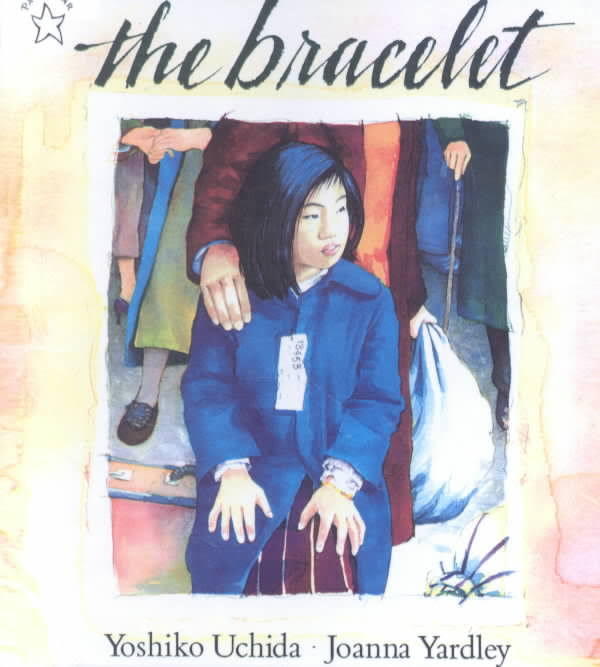The Bracelet (book)
Creators: Yoshiko Uchida (author), Joanna Yardley (illustrator)
A children's picture book by Nisei author Yoshiko Uchida , with illustrations by Joanne Yardley, originally published in 1993. The Bracelet is a story derived from the author's own childhood experiences in an American concentration camp during World War II. The book opens as seven-year-old Emi, her mother and sister prepare to leave their home in Berkeley, California, for Tanforan , a racetrack that has been converted into a temporary camp for Japanese Americans. Emi's best friend, Laurie Madison, brings her a gold bracelet as a farewell gift, and as a reminder of the value of their friendship. Emi vows that she will never take it off, but as she helps clean out the filthy horse stable that will serve has her family's "apartment," the gold chain slips off her wrist and is lost. At first, she is desolate, but Emi eventually realizes that she does not need the bracelet to remember her friend, just as she does not need a photo to remember her father (who has been sent to a separate prisoner-of-war camp in Montana).
The last book Uchida wrote that touched on the Japanese American incarceration, The Bracelet was published posthumously on 1993. It originated as a short story published in 1976 in The Scribner Anthology for Young People .
In 2001, The Bracelet was the subject of a short educational video in 2001 that was a part of the Once Upon a Camp series produced by the Japanese American National Museum and the UCLA Asian American Studies Center.
Reviewers praised both the book's universality of theme and specificity of details as well as Yardley's drawings.
Find in the Digital Library of Japanese American Incarceration
This item has been made freely available in the Digital Library of Japanese American Incarceration , a collaborative project with Internet Archive .
Might also like: A Place Where Sunflowers Grow by Amy Lee-Tai; Baseball Saved Us by Ken Mochizuki; Blue Jay in the Desert by Marlene Shigekawa
| Author | Yoshiko Uchida |
|---|---|
| Illustrator | Joanna Yardley |
| Pages | 32 |
| Publication Date | 1993 |
For More Information
Publisher website: http://www.penguinrandomhouse.com/books/336279/the-bracelet-by-yoshiko-uchida/9780698113909/
Harada, Violet H. "Breaking the Silence: Sharing the Japanese American Internment Experience with Adolescent Readers." Journal of Adolescent & Adult Literacy 39.8 (May 1996): 630–37.
———. “Caught Between Two Worlds: Themes of Family, Community, and Ethnic Identity in Yoshiko Uchida’s Works for Children.” Children’s Literature in Education 29.1 (Mar. 1998): 19–30.
Inagawa, Machiko. "Japanese American Experiences in Internment Camps during World War II as Represented by Children's and Adolescent Literature." Ph.D. dissertation, University of Arizona, 2007.
Potucek, Susan C. "Using Children's Literature to Make History Come Alive: Discussing Prejudice and the Japanese Internment." The History Teacher 28.4 (Aug. 1995): 567–71.
Teorey, Matthew. "Untangling Barbed Wire Attitudes: Internment Literature for Young Adults." Children's Literature Association Quarterly 33.3 (Fall 2008): 227–45.
Reviews
Hale, Robert D. "Musings." Horn Book Magazine 69.6 (November 1993): 770. ["First published as a short story in 1976, this book is important to today's children, who need to be aware of this tragic chapter in our nation's history."]
Kirkus Reviews , Oct. 15, 1993, 1339. ["The carefully researched watercolors, with their irregular edges, are like old pictures ripped from an album."]
Mori, Kyoko. "You're Never Too Old to Be Homesick." New York Times Book Review , Nov. 14, 1993, 21. ["We come to know Emi, through her thoughts, as a strong and likable girl. The minor characters in the story, too, are briefly but deftly portrayed...."]
Philbrook, John. School Library Journal , Dec. 1993, 95–96. ["Uchida employs a simple, descriptive style, allowing the child's feelings to give punch to this vignette without becoming sentimental."]
Publishers Weekly , Sept. 13, 1993, 128. ["Yardley's... hushed, realistic paintings add to the poignancy of Uchida's narrative, and help to underscore the absurdity and injustice suffered by Japanese American families such as Emi's."]
Rochman, Hazel. Booklist , Sept. 15, 1993, 162. ["Rooted as their story is, it is about the wartime refugee experience everywhere, and kids will identify with the injustice that could suddenly invade an ordinary home right here on their street."]
Sutton, Roger. Bulletin of the Center for Children's Books 47.1 (Sept. 1993), 25. ["While somewhat fragmentary in its structure and conclusion, the book... is a gentle, honest introduction to the treatment of the Japanese-Americans during the war..."]
Time , Dec. 20, 1993, 64. ["… this story and Joanna Yardley's warm, elegiac illustrations recall a time for which good explanations are still not available."]
